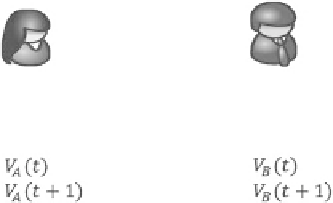Information Technology Reference
In-Depth Information
Before transaction
After transaction
Fig. 12.12
Transaction
other is the property function
F
prop
e
, which shows amount of the property of the
entity
e
shown in Fig.
12.12
.
12.7.3.3 Transactions
The transaction comes off successfully if
F
transA
ð
V
1
;
V
2
Þ>
^
F
transB
ð
V
2
;
V
1
Þ>
:
0
0
Þ
be the value vectors at the time
t
of entities A and B
respectively. Then, the amounts of property the entities have after a transaction are
described as
Let
V
A
ð
t
Þ
and
V
B
ð
t
V
A
ð
t
þ
1
Þ¼
F
propA
ð
V
A
ð
t
Þ;
V
1
; þ
V
2
Þ
V
B
ð
t
þ
1
Þ¼
F
propB
ð
V
B
ð
t
Þ; þ
V
1
;
V
2
Þ
12.7.3.4 Container of the Evaluation Functions
The evaluation functions
F
trans
e
and
F
prop
e
are represented by a combination of
equations and look-up tables. We call this a function container. The mobile agent, a
part of the information capsule, uses the container to evaluate values when the
transactions are requested. Each entity has to register the evaluation functions in
advance.
12.7.3.5 Conversion of the Values into Securities
The first and second values are converted into the third value by issuing securities.
Some parts of values that an entity receives may be the third value and can be
circulated one after another. Other parts of values may be the first or second values.














